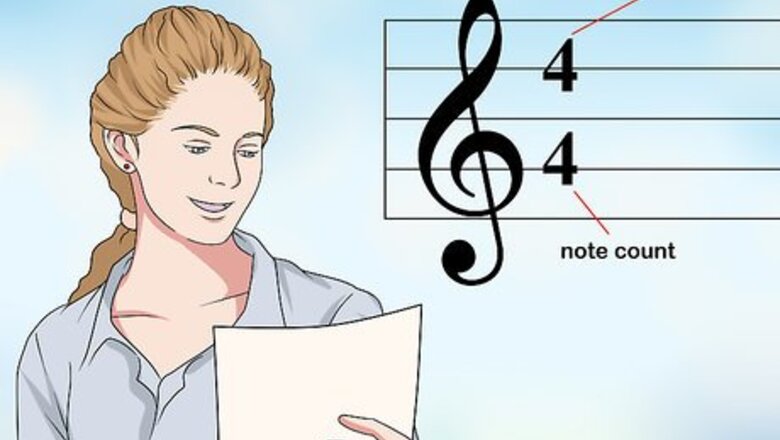
views
Counting Rhythms While Reading Music
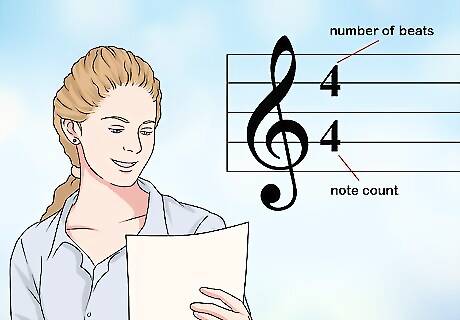
Look at the music's time signature. If you have some sheet music, look for the time signature first. The time signature is listed on the left side of every bar (row) of music. When looking at a time signature, the top number indicates the number of beats in each measure or the space between the vertical bars as you read across the music score. Think of measures as ways of grouping the number of beats in the music into equal parts. The bottom number of the time signature tells you which type of note counts as a single beat. You're likely to encounter one of three bottom numbers: 2, which signals that a half note counts as one beat; 4, the most common option, which signals that a quarter note counts as one beat; and 8, which signals that an eighth note counts as 1 beat. Some examples: 4/4, the most common time signature, means there are four beats in every measure, and each beat is a quarter note long. 3/4 is also common, and means that there are three beats in every measure, and each beat is a quarter note long. 7/8 means that there are seven beats in each measure, and each beat is a quarter note long.
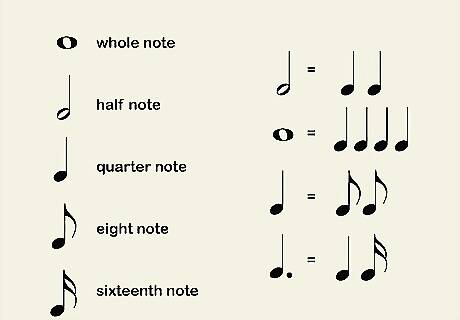
Learn the differences between note values. Different notes cover different lengths of time. The standard note is the quarter note. For most time signatures, the beats are measured in quarter notes. A half note is the length of two quarter notes. A whole note is the length of four quarter notes. An eighth note is half the length of a quarter note. A dotted quarter note is the length of one quarter note and one eighth note. A sixteenth note is 1/4th the length of a quarter note.
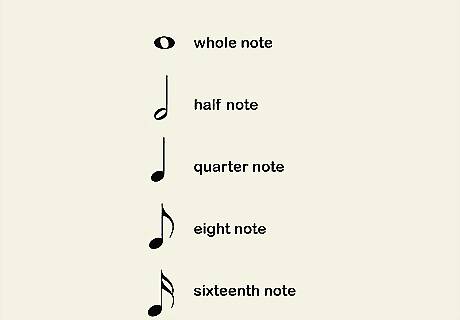
Decipher the note symbols on the page. Notes in sheet music are represented by symbols that consist of vertical lines, open and filled circles, horizontal lines, and flags on the vertical lines. In order to count rhythms on a sheet music, you have to know what note value each symbol stands for. Quarter notes look like vertical lines with a solid circle foot. Half notes look like vertical lines with an open circle foot. Whole notes look like open circles. Eighth notes look like vertical lines with a flag coming off the top and a solid circle foot. When two or more eight notes come after one another, they're connected by a single horizontal line instead of having flags. Dotted half quarter notes look like quarter notes with a dot in front of them. Sixteenth notes look like eight notes with another flag. When two or more sixteenth notes come after one another, they're connected by two horizontal lines instead of having flags.
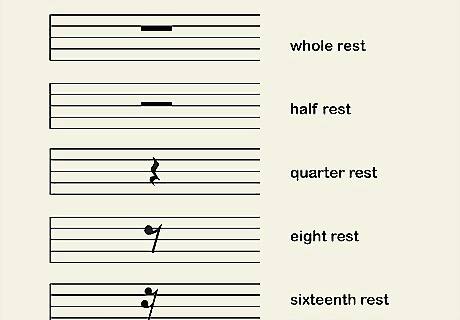
Decipher rest symbols. Rests are simply pauses in the rhythm, when no note is being played or held out. Their values correspond with normal note values. There's quarter rests, eighth rests, etc. They have their own set of symbols that you need to be able to recognize. Quarter rests look like squiggly lines. Half rests look like small bars that lie on the middle line of the staff and face upward. Whole rests look like small bars that hang from the middle line of the staff and face downward. Eight notes look like sevens that have a small circle near the top. Sixteenth notes look like slanted lines that have two small circles near the top.
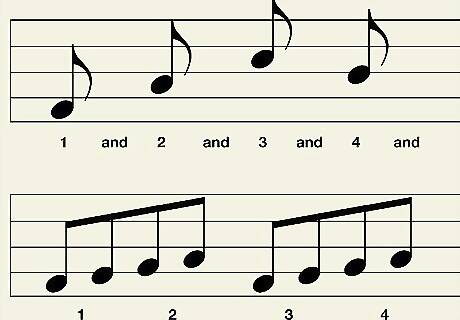
Count the notes. Rhythms are commonly counted out loud as numbers, with each number representing a beat. For notes in between the beats, other words and sounds are used. For example, eighth notes in between beats are counted by saying "and". Eight eighth notes in a row would by counted as "1 and 2 and 3 and 4 and". Sixteenth notes in between beats and in between eighth notes are commonly counted by saying "ee" and "ah". Eight sixteenth notes in a row would be counted as "1 e and a 2 e and a". Use all of this information to count the rhythms on the page. For example, a quarter note followed by a quarter rest, followed by two eighth notes, followed by four sixteenth notes would be counted as "1 *pause* 3 and 4 e and a". If the time signature in this example was 4/4, that would be the end of the measure, so you'd start at 1 again for the next measure.
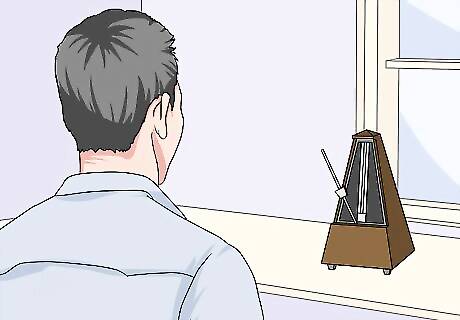
Use a metronome to practice. When you're counting rhythms, it's good to have a metronome handy so that you count with a steady beat. Set the metronome to the tempo indicated on the sheet music, if there is one listed.
Counting Rhythms While Listening to Music
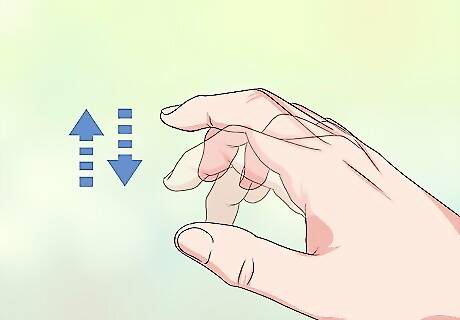
Listen for the time signature. It's impossible to determine with absolute certainty what the time signature of a song is just by listening to it. This is because a song can have the same sounds written different ways. But you can find what the most likely time signature is, which will work fine for the purpose of counting rhythms. First listen for the pulse of the song. Tap your foot or hand along with the song until you find what feels like the beat. This beat is what you will count as quarter notes. Then try to recognize a repeating pattern in the song, such as a chord progression or a drum beat. These are the measures of the song. Then count how many beats are in each measure. That will give you your time signature. For example, if you hear seven beats in every repeat of the chord progression you've got a time signature of 7/4.
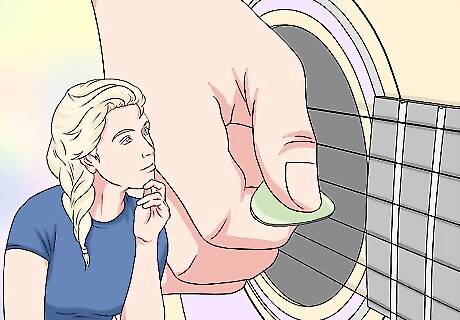
Pick an instrument to follow. You can only realistically count the rhythm of one instrument at a time. If you're going to count the drums, you'll have to listen to all the different parts of the drums when you're counting. For most other instruments, you'll just count each note that's played. For example, if you hear a bass drum hit followed by three snare hits, and each hit takes up one beat, you'll count that as "1 2 3 4".
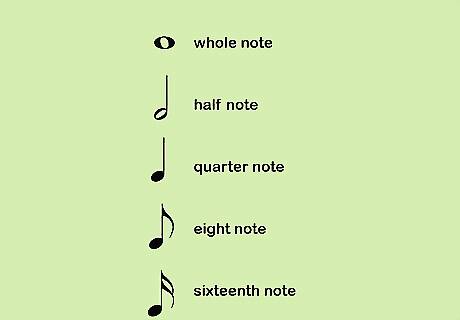
Learn the differences between note values. Different notes cover different lengths of time. The standard note is the quarter note. For most time signatures, the beats are measured in quarter notes. A half note is the length of two quarter notes. A whole note is the length of four quarter notes. An eighth note is half the length of a quarter note. A dotted quarter note is the length of one quarter note and one eighth note. A sixteenth note is 1/4th the length of a quarter note.
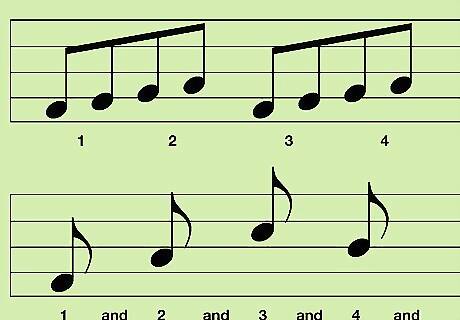
Count the notes. Rhythms are commonly counted out loud as numbers, with each number representing a beat. For notes in between the beats, other words and sounds are used. For example, eighth notes in between beats are counted by saying "and". Eight eighth notes in a row would by counted as "1 and 2 and 3 and 4 and". Sixteenth notes in between beats and in between eighth notes are commonly counted by saying "ee" and "ah". Eight sixteenth notes in a row would be counted as "1 e and a 2 e and a". For example, if you're listening to a guitar melody, and you hear three quarter note long sounds followed by four sixteenth note long sounds, you'd count that as "1 2 3 4 e and a".










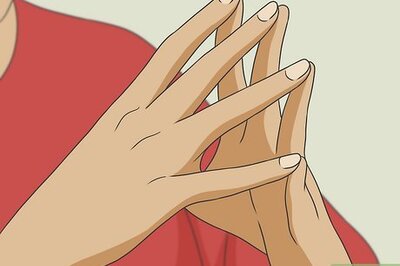








Comments
0 comment